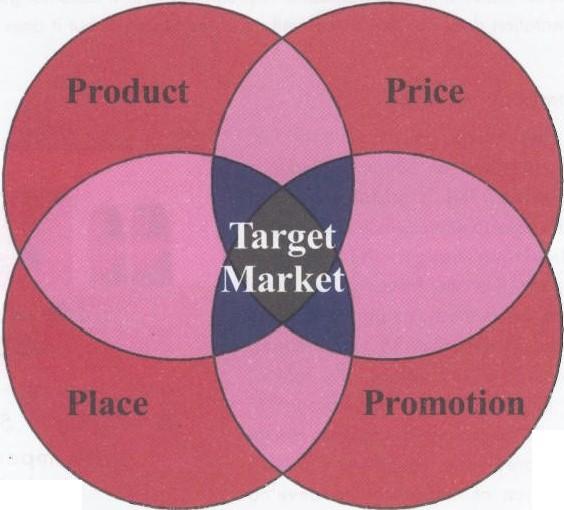Marketing Mix
The marketing mix is a particular combination of the product, its price, the methods to promote it, and the ways to make the product available to the customer. Based on its understanding of customers, a company develops its marketing mix of product, price, place, and promotion. The elements of the marketing mix are intricately and sensitively related to each other. The marketing mix is good or bad as a whole.
All the elements have to reinforce each other to enhance the experience of the customer. When a change is proposed to be made in one of the elements, it has to be checked if the changed element still fits with and reinforces other elements, or has it started contradicting other elements, making the marketing mix less effective in serving customers. Managers must manage these 4Ps in a way that customer satisfaction level is much higher than the competition. Decisions regarding the marketing mix form a major aspect of the implementation of the marketing concept.
Product
Product decision involves deciding what goods or services should be offered to customers. The product or service serves the basic need of the customer. The product provides the primary value to the customer. The customer must have initially got interested in the company primarily because of the product or service it was producing or proposed to produce. All other elements should reinforce the value proposition of the product.
An important element of product strategy is new product development. As technologies and tastes change, products become out-of-date and inferior to the competition. So companies must replace them with new designs and features that customers value. The challenging task is to include the latest available technologies and solutions to the latest needs of the customer in a company’s product.
Product decisions involve choices regarding brand names, warranties, packaging and services which should accompany the product offering
Price
Price is the cost that the customer is willing to bear for the product and the way it is made available to him. Price represents on a unit basis what the company receives for the product which is being marketed. All other elements of the marketing mix represent costs. Marketers need to be very careful about pricing objectives, methods to arrive at a price and the factors which influence the setting of a price.
The company must also take into account the necessity to give discounts and allowances in some transactions. These requirements can influence the level of list price chosen. If discounts and concessions have to be given in certain transactions, the list price should have a negotiation margin built in it. Payment periods and credit terms also affect the real price received in any transaction. These kinds of decisions can affect the perceived value of a product.
In comparison to other elements of the marketing mix, the price can be changed easily. But an ill-considered change in price can change customer perceptions about the value of the marketing mix. In the absence of any objective knowledge about the quality of the product, the customer builds a strong association between price and quality. If the price of a product is reduced, customers may start regarding it as an inferior quality product.
If a company raises the price, customers may consider it a high-quality product, but there is also the risk that customers may regard the price too high for the value that they are getting from the product. Price change, though easy to make, should always be done taking into consideration the effect the change will have on the attractiveness or otherwise of the marketing mix.
Promotion
Decisions have to be made with respect to the promotional mix: advertising, personal selling, sales promotions, exhibition, sponsorship, and public relations. By these means, the target audience is made aware of the existence of the product and the benefits that it confers on customers.
The type of promotional tool used has to gel with other elements of the marketing mix. An expensive product, like machinery, with a limited number of customers, should be promoted through personal contacts between buyers and salespersons. Advertising in the mass media would be wasteful as the number of customers is far too small, and it would be ineffective as the customer will not make a decision to buy such an expensive product based on little information provided in an advertisement. He will require extensive information to be able to make a choice. But an inexpensive product bought by the mass market can be advertised on the mass media.
Even the nitty-gritty of a chosen promotional tool should enhance the marketing mix. The media used, the celebrity chosen to endorse the product, the training provided to the salesperson, etc. should reflect and reinforce other elements of the marketing mix.
Normally the company makes its first contact with customers through its promotional efforts. A customer does not buy a product unless he has formed certain expectations about the product. Promotion shapes the expectations of customers about the product. Used rightly, promotion can raise customer expectations and drive sales.
But if a product is hyped and unrealistic, though customer expectations are raised, he will be disappointed when he actually uses the product and does not find it up to his expectations. Such disappointments engender negative word-of-mouth complaints and a permanent dent in the company’s reputation
Place
Place involves decisions concerning distribution channels to be used, the location of outlets, methods of transportation and inventory levels to be held. The product should be available in the right quantity, at the right time and place. Distribution channels consist of independent intermediaries such as retailers, wholesalers, and distributors through which goods pass on their way to customers. These intermediaries provide cost-effective access to the marketplace.
It will be extremely costly and cumbersome if the manufacturer had to set all the infrastructure needed to manage the transfer of goods to the customers. The manufacturer has to manage and structure relationships with these intermediaries in such a way that the interests of the manufacturer and intermediaries ore served.
Distribution channels perform three distinct functions. They transfer products from the manufacturer to the customers, they pass information from the manufacturer to the customers, and they retrieve payment from the customers to the manufacturer. It is possible to segregate these three functions as alternate means of delivering products, passing information and collecting money are developed. In internet marketing, information is provided on the manufacturer’s website, the product is sent from the manufacturer’s store to the customer through courier service, and payment is collected by banks through credit cards.
A company should have an open mind while designing its distribution strategy. The three functions have to be performed but it is not essential that all three functions are performed by one channel. Three separate channels con perform a function each, depending on each channel’s efficiency and effectiveness in carrying out the function.






